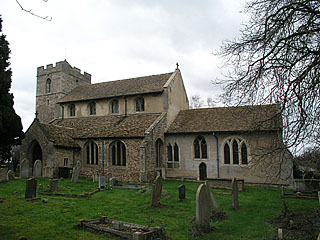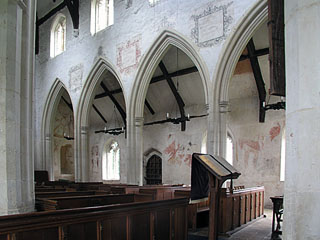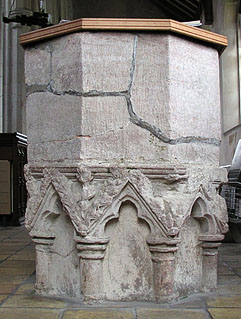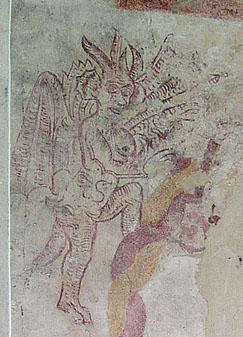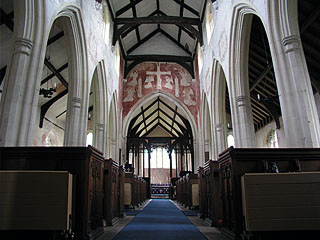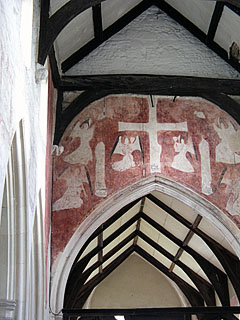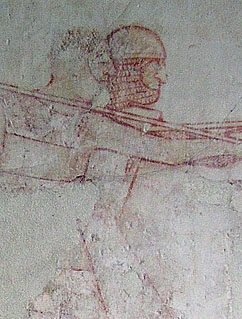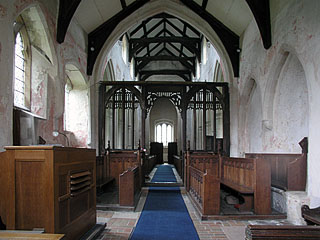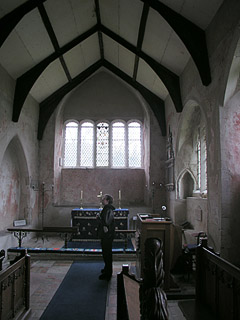The church at Kingston has had rather a battered history. The oldest bits of building remaining on the site are from around the turn of the 13th century: there’s also a round window and a filled-in archway fossilised in the west end of the north aisle, which looked to me like something from that period. These fragments were incorporated into a new building in 1352.
Unlike many villages in the area, Kingston was quite prosperous, due to its convenient location as a stopping point on the main road from Cambridge to Sandy (which still runs in the valley below the church). So, they were able to rebuild, and in quite grand style, if the parts of the chancel surviving from that period are indicative.
Then, in 1448, a great fire destroyed the nave - a disaster followed in short order by the collapse of the weakened tower. Fortunately the parish had a powerful new patron (having been given as part of its endowment to Kings College by Henry VI). Nonetheless, it was 40 years later (during which I assume the parishioners were forced to use the chancel) before a rebuilding commenced, this time in lofty Perpendicular style.
The loftiness isn’t very apparent from the exterior, as the church squats on the top of the hill looking snug and compact. The tower is small, and rather plain save for two niches on either side of the west window. Apparently it contains three bells, one of which is 14th century and amongst the oldest in the country. There are some bits and bobs of old stonework reset into the tower walls, but for the most part it is built of fieldstones like the rest of the church, with a fair bit of rust-coloured carstone in the mix. A plastered clerestory sits on top of the nave, and there is a rather nice little porch. Pretty, but not exceptional.
Inside, that impression changes. The nave is of four bays, and of a particularly elegant design; tall and narrow, with graceful piers. On the north and south faces each is a plain downwards continuation of the line of the wall, and there are half-octagonal engaged shafts on the inner faces, with unusually simple moulding over the top. The tower arch is of the same design, though even more austere: given how short the tower itself is, the arch is surprisingly stately and tall. Above the clerestory are a set of eroded heads as corbels for the roof, which is itself a good tie-beam of very dark timber, contrasting with the white plaster of the ceiling itself.
But when you really enter All Saints and St Andrew, I doubt that you will spend much time gazing at the ceiling or the nave arcades – there are much more exciting things to peer at on the walls. However, before we go on to those, I’ll briefly mention the font. Perpendicular octagonal fonts are very common, of course, but this is a survival from the Decorated church, and unusual for that period. I liked the design a lot: the stem has been cut away to form eight engaged shafts with little trefoil arches over the top, complete with leaves and decorative moulding.
These support a very thin string-course around the waist, above which is a completely plain straight-sided block for the bowl. It sits at the west end of the south aisle, with some nice nineteenth century benches along the walls around it.
But Kingston’s most remarkable feature is not the font, nor even the shapely piers. This is a church endowed with a magnificent collection of wall-paintings, with representatives from most periods of the church’s history.
Starting with the most recent, there are some 16th and 17th century passages of scripture painted in decorative frames sitting above the piers and between the arches of the nave arcades.
Next, we have a wonderful collection, from just after the reconstruction in the late 15th century. On the west wall of the north aisle there is a wheel symbolising the seven acts of mercy. In one of the openings I could just about make out a house with a pair of figures, but the images are otherwise very indistinct.
Below it is a rather more visible devil drawn in red outline – he has scaly wings and so on, but a surprisingly human face. In his stomach is another face, with a more unsettling expression. He seems either to be climbing up or rotating a wreath of intertwined gold and red vines, forming a circular frame which would presumably once have contained images of the seven deadly sins, to match the seven acts of mercy.
At the westernmost end of the north aisle wall is a saint sitting inside either a building or a tall throne. Then, east beyond the north door, is St George. His horse is visible as a white shape against the red ground, with a decorated bridle clearly visible. The saint himself has disappeared, although various bits of oxidised paint hint at his outlines, and one can see the shape of his lance pointing down into the mouth of a rather primitive looking dragon (again, just a silhouette). Finally, east of St George is an image of St Christopher. His upper body is gone, but we can still see the edge of his mantle, his knees and his staff.
Most magnificent of all is the painting above the chancel arch. Both the wall above the arch, and the ends of the walls above the arcades, are completely red (though I wonder whether the colour was different at some point, and has just corroded to this ominous shade). On the east wall are the remains of brackets which originally supported statues of St Mary and St John, standing on either side of the rood itself, which I think must have rested on the top of the rood screen, since there is no room for a central bracket. Unpainted patches of wall indicate where the sculptures stood: the most distinct is the cross itself, the shape of which survives entirely, along with the form of Christ’s knees pointing out to one side.
Around the supporters and the rood, the wall is painted with a group of six angels. They are effectively just white shapes against the red background now, their details having been lost to time, but where the backs of their wings curve round towards us, the pigment (which might, I think, originally have been silver) has turned to black. The images are, as a result, simple to the point of abstraction – but the curve of the wings is finely done, and that black pigment does give the sense that they are floating in space.
Two of the angels fly on either side of the rood itself, bearing chalices. The other four frame the whole ensemble – the two above censing the air with thuribles, those below playing musical instruments. It’s a lovely sight.
Below, bits of the screen survive. The loft is gone, of course, but doorways on either side indicate where it must have been. (Incidentally, if the rood did rest on the loft, rather than hanging from the wall, it must have been extremely tall and impressive since, judging by those doorways, the loft must have been really quite low). The screen as it now survives is rather odd: the central opening has had 17th century woodwork inserted around the top, but the main structure is old.
There are two very large perpendicular lights on either side with very fiddly tracery, which I found a little too repetitive and mechanical to be really beautiful. Above those side lights the arches are of plain unfinished wood, and there are engaged shafts on all of the uprights, which gives quite a clear idea of where the vaulting for the loft would have gone.
Moving through into the chancel, we find the oldest wall-paintings of all. This part of the church survived the 1448 fire, and significant parts of the structure survive from the 12th and 13th centuries (though most of it is from the 14th century rebuilding). On the north wall, there are some fragments of swirling foliage, and also two 13th century foot-soldiers bearing lances. They are very nicely drawn, and look younger than the nave paintings: the way they were drawn – red lines on a white background – has aged better than the ambitious coverage of pigments in the later paintings.
The pair face eastwards, spearing at something with their lances. The left-hand soldier wears chain-mail and has a big Roman nose: his companion has a helmet and looks like his nose has been broken many times.
This north wall has, in addition to the paintings, a number of interesting openings. Below the two soldiers is a doorway that presumably led through into a vestry, now blocked up. To the west is an alcove with a double arch over the top, and a bench along the bottom, which (until later windows disrupted the scheme) was matched on the south side. We know that there was a college of priests at Kingston, so this was presumably the decoration for the choir stalls: the RCHM thinks this is a survival from the 13th century building.
Going further east along the north wall, there is a big recess about six feet across – perhaps intended for a tomb. Even further along is a tiny niche set into the corner of the wall, about five feet from the ground. It seems to have been cut from a single block of stone, with the inside hollowed out and protected by a tiny little carved arcade. It is a most mysterious little thing, whose function is entirely obscure – perhaps it is a reset fragment from somewhere else?
The east window is a 16th or 17th replacement, with five plain lights and a square head. There are some scraps of medieval glass, including a roundel containing a lovely image of a deer.
The keyholder, a wonderful gentleman called John who lives in the old rectory to the east of the church (itself a splendid and ancient building), told us that he has the tracery of the original window stored somewhere – one of my ambitions, for several years now, has been to lay it out on his lawn and see what it looks like.
On the south side, facing the tomb niche, is another window with the piscina cut diagonally into the eastern splay, which is an unusual set-up (another 13th century survival, apparently). Next to it is a nice Jacobean wall-memorial which has recently been repainted. It commemorates Dr Fogge Newton, Provost of King’s College and rector here, who died in 1612. There are numerous painted shields – including those of the College and of the university – along with the usual whimsy of Corinthian columns, balls, obelisks and strapwork.
All Saints and St Andrew is kept locked, but there are keyholders listed
